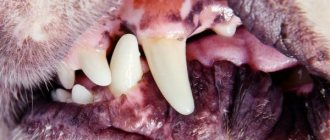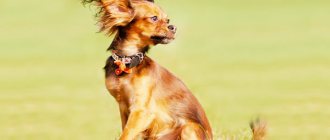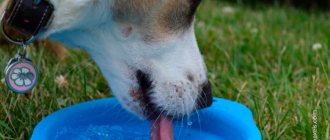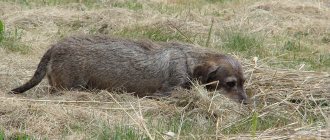It may be disgusting, smelly, and unpleasant, but the color of your dog's poop can tell a lot of stories about your pet. It can tell you what it ate and even if your canine friend suffers from a certain disease or not. This is why fecal testing is often a routine procedure in many veterinary laboratory and diagnostic tests, as it can reveal a lot about what is going on inside your pet's body. So, what does the color of dog poop actually mean?
Journey through the dog's digestive tract
Since we're talking about feces, which is technically the end result of a physiological process known as digestion, we need to take a close look at the path of any given type of food through the gastrointestinal tract, since the color of a dog's poop depends on what happens somewhere along the way.
The digestive tract is a very long tube that starts in the mouth and ends in the anus. This is a contiguous tract, and between the esophagus and the duodenum of the small intestine there will be only one major outlet, forming a pouch-like structure known as the stomach.
When food enters a dog's mouth, it travels down the esophagus and into the stomach, where a whole bunch of stomach fluids try to chug, digest, and break down all the different food molecules into smaller pieces in preparation for final digestion and absorption in the small intestine. The food then passes through the duodenum—the first section of the small intestine—where it is filled with juices from the liver, gallbladder, and pancreas to ensure that all macromolecules of the food's nutrients are properly digested for absorption.
© shutterstock
The gallbladder secretes bile, a greenish substance that facilitates the processing of fat by various digestive enzymes. There are other enzymes and digestive fluids from the pancreas and liver, each of which adds additional color to the food. Food passes the entire length of the small intestine—the jejunum and the cecum—until it reaches the large intestine. By this time, water and other substances are constantly being reabsorbed by the body, forming a harder mass that we now call stool or feces. When nature demands, this stool is passed through the rectum and exits the anus.
Brown and well formed
This is generally considered a normal stool color in dogs. The brownish tint occurs due to the yellowing of bilirubin, a substance present in bile. This is the same substance that gives skin a slightly brownish to pinkish hue. Do not confuse this with jaundice, as this is due to increased bilirubin in the bloodstream. As long as your dog's brown stool doesn't show any additional colors, such as streaks of red or yellow, you should be happy that your pet is fine. In addition, it must be correctly formed. It may be brown, but if it is more watery than usual, that is also abnormal.
Red or brown with red veins
Any reddish color to a dog's stool always indicates active bleeding in the lower gastrointestinal tract, usually limited to the large intestine, rectum, or even the internal structures of the anus. This is different from bleeding in the small intestine because this structure is actually several feet long. To give you an idea, a dog's small intestine alone can be 2.5 times the length of your dog's body. So if your dog's body length is around 50cm, you can expect his small intestine to be around 100cm in length. If the bleeding occurs anywhere in the duodenum, the time it takes to reach the rectum and anus will be long enough for it to harden or thicken. Since you see bright red streaks, the bleeding is occurring in the cecum or the colon itself. Other causes could be colitis, a colon tumor, a parasitic infection, or even an infection of the anal glands.
Frequency of defecation
You need to carefully monitor how and with what frequency your puppy walks “big”. This can also provide a lot of valuable information about the nature of the disease:
- If your pet poops approximately every hour , but watery feces come out in small portions, and the puppy has to push hard to do this, you can assume the presence of colitis.
- On the contrary, when the frequency of bowel movements is up to four to six times a day , when the baby does not strain at all, but a lot of feces come out each time, this almost certainly indicates pathologies localized in the small intestine.
Black or resinous
This is the opposite of the color of a dog's stool, which has bright red streaks. Black or tarry stool is always a sign of upper gastrointestinal bleeding, such as from a stomach or duodenal ulcer. Given the exceptional length of the small intestine, blood in the stool will take significantly longer to solidify. By the time it passes through the rectum and anus, it will already be significantly curled up and you will no longer see the red spots. One of the leading causes of upper gastrointestinal bleeding in dogs is the consumption of certain medications, such as aspirin. Therefore, it is important to always consult with your veterinarian about the medications you plan to give your dog.
Physical condition of the animal
Finally, how your puppy looks and how well/bad he feels matters a lot:
- Weight loss, malnutrition - suggests small intestinal disease.
- Normal appetite, minimal weight loss - suggests colon disease.
- Vomiting in combination with diarrhea and weight loss also indicates pathologies of the small intestine.
White and chalky or brown with white speckles
If you see white specks in your dog's feces, these could be the eggs of certain intestinal parasites that have passed through the feces. However, if your dog's feces are whitish in color or perhaps even look chalky, then there is a high chance that your dog may be suffering from hypercalcemia, or a condition in which excessive amounts of calcium are released into the bloodstream. This can occur with bone fractures or any other type of bone injury because the calcium released by the bone matrix must be reabsorbed into the bloodstream.
© shutterstock
Purple or pink
If you see what looks like raspberry jam in your dog's stool or that there is an unusual amount of blood passing through your pet's rectum and anus, this is often a sign of hemorrhagic gastroenteritis, or severe bleeding caused by inflammation of the small and large intestines. If you notice this type of feces on your dog, be sure to seek emergency veterinary care immediately. You must understand that thousands of dogs die every year due to hemorrhagic gastroenteritis, which can lead to massive blood loss, electrolyte imbalance, tissue hypoxia and death. However, with timely treatment, your dog can prevent disaster.
The dog has orange diarrhea: Diagnosis and recognition of the cause
When contacting the clinic, a veterinary specialist will take the following measures:
- Anamnesis collection.
- Inspection.
- Thermometry.
- General blood and urine analysis.
- Blood chemistry.
- Stool analysis - scatological examination.
- Ultrasound of the abdominal organs.
- Blood test for piroplasmosis (if suspected).
- Rapid tests for canine distemper, parvovirus enteritis.
Watch the video: THE BEST DOCTOR'S ADVICE - Your dog will be healthy!
Grey
Remember what we said about how the brown color of dog stool is a function of bilirubin found in bile acids? Well, if there is not enough bilirubin or bile salts, your dog's feces will appear pale or grayish in color. Because bile salts are produced in the liver and stored in the gallbladder, the absence of bilirubin or bile salts in the stool may mean there is a problem in the liver or gallbladder. However, the most common culprit is an obstruction of the common duct, which is where the ducts from the liver, pancreas and gallbladder meet as they go to the duodenum, which drains fluids and enzymes. In such cases, if an obstruction is suspected, surgery to remove the obstruction may be required.
Green
If you notice that your dog's poop has taken on a greenish tint, there's a good chance that he just likes your grassy lawn. Dogs are known to eat grass, especially if they have an upset stomach. So don't be surprised if you see greenish poop on your dog. Unfortunately, eating grass is not the only reason why your dog's poop may turn green. In some cases, this may be due to rat bait poisoning, a parasitic infection, or other gastrointestinal problems. The only thing you can do to identify grass-related green poop is to look for telltale signs of undigested grass or leaves. If you can't find one, then you'd better take your dog to the vet.
What should I do?
We have already repeatedly emphasized above that in most cases of yellowing diarrhea, it does not hurt to immediately contact a veterinarian. This sign does not indicate anything good, so a specialist check is quite capable of saving your pet’s life. But in some cases, when the puppy seems to be doing well, you can try to deal with the problem yourself.
For this purpose, experienced breeders and veterinarians themselves advise using pumpkin puree (without spices, sugar and salt, of course). The one produced by baby food manufacturers is perfect. A more affordable product is regular boiled rice, which perfectly relieves many cases of diarrhea. This food must be given for two to three days.
If during this time the animal’s condition stabilizes and the diarrhea subsides, the puppy can be gradually transferred to a regular diet. However, this must be done gradually, over a period of at least ten days. Every day you need to add about 10% of regular food to pumpkin or rice. In cases where the pet's stool begins to loosen, the pet is switched back to rice and pumpkin puree until the feces "stabilize" again.
Orange
You might think that yellowish colored dog stool is a sign that they ate too much carrots or pumpkin, but in fact it is a possible indication of gallbladder or liver problems. There may be too much bilirubin in the stool, causing it to appear more orange than normal brown. However, most often, orange-colored stools are watery, reminiscent of diarrhea. Therefore, if you see stool of this color in your dog, it is best to consult a veterinarian.
What to do if problems could not be avoided?
First of all, you need to pay attention to your pet’s diet. It is recommended to temporarily feed food that is easily digestible. These can be gastroenterological diets from such brands as Monge, Royal Canin, Hills, Proplan, Farmina, Happy Dog . Provide access to fresh water.
Additionally, you can add probiotic supplements to your diet, such as Forti Flora and Vayo .
To stop diarrhea and relieve intoxication, you can give the veterinary drug Enterozoo or Smecta in a pediatric dosage. If it is not possible to show the dog to a doctor, then you can give Regidron to replenish fluid in the body. Loperamide without a doctor's prescription ; it can cause intestinal bleeding.
If your attempts to help your pet are unsuccessful, or there are additional symptoms such as lethargy, refusal to feed, vomiting, or fever, then it is better to immediately seek help from qualified specialists.
The veterinary clinic will be able to take a swab to check for infection. It is better to take a stool sample with you - this will simplify the diagnosis. Blood tests are necessary to assess the degree of dehydration (dehydration) in order to understand whether there are signs of a viral or bacterial infection, or whether there are functional problems of internal organs. Ultrasound diagnostics helps to find out whether there are structural changes in tissues.
If necessary, additional diagnostics are prescribed. Before the test results, the doctor will prescribe symptomatic treatment aimed at replenishing fluid losses and improving the general condition, and will tell you what you can do at home on your own.
In more complex cases and after diagnosis, multiple visits to the clinic may be required for procedures such as IVs.
To enlarge the picture, click on it
Yellow
If you notice a yellowish-orange color in your dog's stool, there is a chance that it is due to bile duct or liver problems, as we mentioned above. The only way to be sure of a possible connection with liver or biliary problems is to compare it with other clinical data. For example, if you also notice yellowing of your dog's conjunctiva, as well as the mucous membranes of the eyelids and the inside of the lips, then there is a possibility of liver disease, possibly hepatitis. This leads to an abnormal accumulation of freely circulating bilirubin in the blood, which eventually ends up in the stool, giving it a bright yellow or orange hue.
© shutterstock
However, if yellowing of the stool cannot be confirmed by other clinical signs, and the stool itself is quite watery or slimy, you may be dealing with a food intolerance. Again, you must correlate this with other manifestations, as food intolerance in dogs almost always manifests itself as vomiting and abdominal pain.
Stool consistency
Above we have not described all the characteristics of feces that you should always pay attention to.
Consistency plays a very important role:
- Loose stools (not just liquid, but watery). An alarming sign, as it indicates severe irritation and degradation of the intestinal mucous membranes. Occasionally, this pathology is a consequence of prolonged feeding with dry food. By the way, they are generally contraindicated for puppies. Please note that if you have watery, bubbling stool, you should contact your veterinarian immediately.
- If the stool is not only yellow, but also watery and bubbly , this is a sign of many bacterial infections.
- Semi-liquid yellow stool with a “greasy consistency” is a bad sign, indicating poor absorption of lipids. Most likely, we are talking about serious damage to the pancreas (as a result of which too few digestive enzymes are released into the intestinal lumen).
- But what if the feces are very similar to pure yellow mucus ? This indicates some severe catarrhal inflammation in the large intestine.
Greyish with a greasy appearance
If your dog's stool is slightly grayish in color and really slimy, oily, or greasy, then your dog may have exocrine pancreatic insufficiency. They call it exocrine to distinguish it from the endocrine function of the pancreas, which is mainly its ability to produce and secrete insulin and glucagon to regulate the metabolism of carbohydrates and other substances in the body. The exocrine function of the pancreas is directly related to its ability to produce and secrete digestive enzymes such as lipases, amylases, and proteases, which digest fats, carbohydrates, and proteins, respectively.
We mentioned above that as food passes through the duodenum, it fills with fluids from the liver, gallbladder and pancreas. The gallbladder secretes bile salts into food so that the fat in food can be adequately coated. This makes them relatively easy to digest by pancreatic lipases. If there is a problem in either of these two mechanisms, or even both, then the fat contained in food is not digested properly and is not absorbed into the blood. Instead, these fats will pass through the intestines, rectum, and anus, causing oily or greasy stool.
Some of the most common conditions that can cause exocrine pancreatic insufficiency in dogs can include pancreatic cancer, cystic fibrosis, and even chronic pancreatitis. If the underlying problem is the release of bile salts, then possible causes may include gallstone formation and extensive liver damage.
Other potential canine conditions that can cause steatorrhea—fatty feces—include intestinal malabsorption secondary to giardiasis, inflammatory bowel disease, overgrowth or harmful bacteria, and even celiac disease, although the latter condition is very rare in dogs.
High-quality treatment from specialists
We offer our visitors the highest level of modern diagnostic equipment. A dog has diarrhea Rostov-on-Don - we have the best treatment. Patients in intensive care and hospital are under constant medical supervision. The veterinary pharmacy, located in the lobby of the clinic, sells all the necessary medications to treat your pets. Here you will find EVERYTHING without long searches and with a guarantee of high quality! If necessary, you can order delivery of medicines, food and pet accessories to your home. To transport your pet, use our pet taxi, which will take you and your pet to the veterinary clinic from anywhere in Rostov-on-Don and the region. Call us, we will be happy to answer all your questions. By asking us a question you can get a free consultation with a doctor. Rest assured, by visiting the website of our veterinary clinic, you will always be able to find an up-to-date answer to your question, be it a description of a procedure or a description of rare diseases of dogs and cats. Our veterinary clinic conducts active educational work. On our website you can read articles devoted to various aspects of the treatment and care of animals, as well as a modern view of veterinary medicine.
Diarrhea in dogs is a common clinical problem among veterinarians. Acute diarrhea occurs very suddenly, lasts a short time, and usually goes away completely within 2-3 weeks. In this case, the feces may be watery and even contain bloody clots. Diarrhea, an illness in dogs and other animals, can be a one-time occurrence or sometimes last for several months. If one-time cases do not cause panic in the owners, then prolonged diarrhea should mean the presence of a problem, the solution to which should be found by an experienced veterinarian. Contacting a veterinarian will resolve the problem.
Ensuring “normal” stool color
Feeding your dog a quality diet should help prevent any fecal problems. Limiting your intake of human foods can also promote healthier digestion, even if these foods are generally considered safe. Keeping your home and premises free of trash, compost piles, parasites, vermin and other harmful objects, organisms and chemicals should also be an integral part of the best pet care. However, you should also keep your medications out of reach of pets.
The color of a dog's stool can tell us a lot about its feeding habits and how its body actually reacts to the substances it puts in its mouth. It is our responsibility as pet parents to understand these stool colors and what they really mean so we can know what to do next.
Author of the article : Olivia Williams.
Treatment of diarrhea
Typically, veterinarians advise not to feed your pet for 12 to 24 hours. But at the same time, the animal must have a large amount of water to drink. This is necessary in order to avoid dehydration. Before treating an animal, you should consult a doctor. After all, there are many reasons for the appearance of diarrhea.
Specific treatment requires an accurate diagnosis. At the first stage, the doctor can prescribe treatment that will help quickly eliminate the symptoms, and will definitely prescribe tests in order to identify the true cause of diarrhea. In addition, tests will help against infectious or bacterial diseases. Symptomatic treatment includes one of the following:
- After a half-starvation diet, the animal must be fed with easily digestible food. It can be boiled chicken, beef, which is mixed with low-fat cottage cheese, potatoes or rice. It is recommended to follow a light diet for the next few days. After this, gradually switch to your usual diet.
- Infusion therapy can be used to prevent dehydration.
- If an animal is diagnosed with hemorrhagic gastroenteritis, the mandatory use of antibiotics in treatment.
- To protect the intestines, the doctor prescribes adsorbents and drugs that protect the mucous membrane.
- The doctor may prescribe other medications, for example against helminths. But all medications are prescribed depending on the degree of the disease and the characteristics of the animal’s body.
A large number of dog owners, at the first symptoms, run to the pharmacy and buy drugs that can seriously harm the animal, although they will eliminate the symptoms. Only a doctor can tell you whether it is possible to give it to a dog for diarrhea and what other medications to use.
A popular drug among medications is rehydron. This is a powder that must be diluted with water and given to the dog to drink. The product helps to quickly eliminate diarrhea, has a beneficial effect on the intestinal walls, and can be used for diarrhea with blood. It heals wounds in the intestines well.
Do not use any medications without visiting a veterinarian. Dogs have very sensitive bodies and improper treatment can have lifelong consequences.
Preventive measures
The best treatment for your pet is home care and examination by a professional veterinarian. To ensure your pet’s health is excellent and you don’t have to go to the clinic, just follow a few simple rules:
- follow all doctor's recommendations. If your dog still has diarrhea, it is better to stick to the diet and if there are difficulties in treatment, be sure to consult a doctor;
- Constantly monitor the general condition of the animal. Monitor the amount and condition of stool, whether there is blood or mucus. Watch carefully to see if the dog has an appetite or weakness;
To avoid diarrhea in dogs, it is enough to pay enough attention to your pet and take care of the right diet. Only good food will make your pet healthy.
Do not neglect regular visits to the veterinarian and carry out tests. Even routine diagnostics can indicate in advance possible disorders in the body that can be quickly eliminated. And although diarrhea can be quickly eliminated, treatment can affect the further functioning of the entire body. If you see deviations from the norm in the dog’s behavior and observe the presence of diarrhea in the dog, you should not hesitate, but immediately go to see a doctor.










